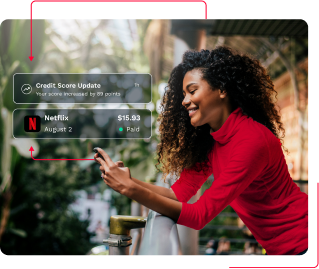
There are lots of reasons to build credit. Maybe you want to qualify for an auto loan or mortgage. Maybe you’re tired of paying high utility deposits and interest rates. Maybe you’re a budding entrepreneur hoping for a business loan.
No matter what your “why” is, having good credit creates a firm foundation for your financial future.

Your credit score is a three-digit number between 300 and 850 that tells lenders how likely you are to repay a loan. The three major credit bureaus (Experian®, Equifax® and TransUnion®) use a specific set of criteria to determine your credit score.
One of the most influential factors of your credit score is called credit usage, also referred to as credit utilization or debt-to-credit ratio. Your credit usage is calculated by tallying up how much debt you owe vs. how much credit is available to you to borrow.
While auto loans and student loans do count toward your total debt, credit usage focuses on a category called revolving debt. Revolving debt is a line of credit, usually a credit card, that you can use and pay over and over with a varying monthly payment amount.
Auto loans, mortgages, and student loans are called installment debt. Paying down your installment debt WILL boost your score, but it will not affect your credit utilization.
To boost your credit, you should aim for a credit usage percentage below 30%. For example, if you have one credit card with a $1000 limit, keeping the balance below $300 will have positive effects on your FICO score.
Improving your credit usage to boost your score can be done in two ways:
Another way to increase your available credit is by opening a new credit card. Like requesting a credit limit increase, a new card could become a tempting new source of debt.
An additional caveat is that new lines of credit lower your overall “credit age,” which is the average length of time that you’ve had each credit account. A higher credit age shows more stability, which raises your credit score.
Improving your credit usage percentage is one of the fastest ways to raise your credit score. You’ll see a score increase as soon as your credit card providers report your new balance or limits to the credit bureaus.

Yes, it takes time to build good credit with timely payments. But in the short-term, late payments will cause your score to dip as soon as they’re reported to the bureaus. These late payments can stay on your credit report for 7 years, and it can be difficult to correct their impact on your score.
There are many reasons that someone might be late on a credit card or loan payment. Financial hardships from employment gaps or medical emergencies can throw even the best budget off track. Sometimes, human error is to blame (hey, nobody’s perfect).
If you do find yourself falling behind, communication is key. Especially post-pandemic, many creditors have options in place to help borrowers get on track after periods of delayed payments. Call your credit card provider and ask if they’re willing to consider removing a delinquent payment from your credit report once you’re caught up.

Each of the three major bureaus is legally obligated to provide a free copy of your credit report to you annually. Contact Experian®, Equifax®, and TransUnion® to request a copy. Then, carefully scrutinize each report for inconsistencies.
Your credit report could contain loans you haven’t taken out, credit inquiries you never agreed to, or connections to addresses you’ve never lived in. These discrepancies could be due to a mixup, or they could be signs of a serious identity theft situation.
If you find errors on your credit report, you’ll need to dispute them. Begin by sending a letter to the affected credit bureaus explaining the inaccuracy. Include a copy of the credit report that shows the item of concern. The bureau is required to investigate and respond within 35 days.
.png)
Most of these strategies focus on improving your existing credit. But what are the options for someone who is starting out with no credit history?
One way to build credit is by using a secured credit card. A secured card is a credit card that is backed by a cash deposit that the lender holds onto to offset the risk of making a loan to a person without a credit history. Usually, this deposit is equal to your credit limit on the secured card.
A secured card has pros and cons. On the positive side, it is a way to begin building your credit history without a risk of going too far into debt. However, these cards usually carry high interest rates despite being secured by your own cash.
Additionally, secured cards carry low balances. That means that you can’t spend much without the risk of increasing your credit usage (and decreasing your FICO score).
.png)
It seems absurd that you can pay rent, utilities and more on time every month and still struggle to build credit. StellarFi agrees.
With no credit check and no interest charges, Stellar enables you to build credit with the bills you already pay. And, you can build credit without a secured credit card or high-interest loan.
Here’s how it works:
What happens next is up to you. What will you do with that “stellar” credit score?

StellarFi (StellarFinance, Inc.) and its affiliates do not provide financial, tax, legal, or accounting advice. This material has been prepared for informational purposes only, and is not intended to provide, and should not be relied on for, tax, legal, or accounting advice. You should consult your own financial, tax, legal, and accounting advisors before engaging in any transaction. StellarFi receives a referral fee from the partners mentioned in this article.

With StellarFi, your bills are paid on time and reported to Experian® and Equifax®.